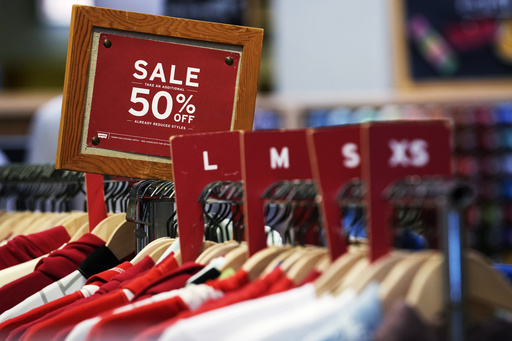WASHINGTON — Inflation in the United States saw a notable uptick last month, largely driven by increased prices for groceries, gas, and rent. This surge presents a challenge for both families and businesses already facing high costs and likely reinforces the Federal Reserve’s intention to hold off on further interest rate cuts.
According to the Labor Department’s latest report, the consumer price index rose by 3% in January compared to the same month last year, climbing from a 2.9% increase noted in December. This marks a rise from a 3.5-year low of 2.4% recorded in September.
The latest numbers indicate that inflation has remained persistently above the Federal Reserve’s target of 2% over the past six months, after experiencing a steady decline over a year and a half. Elevated prices have become a significant political issue, especially for former President Joe Biden. Meanwhile, President Donald Trump has vowed to address rising prices immediately upon taking office, although many economists express concerns that his proposed tariffs might temporarily exacerbate costs.
The unexpected rise in inflation may dampen some of the business optimism that followed Trump’s election, which was fueled by promises of regulatory relief and tax cuts. On Wednesday, the Dow Jones Industrial Average saw a significant drop of 400 points during midday trading, and bond yields increased, reflecting traders’ expectations for sustained high inflation and interest rates.
“We’re really not making any headway on inflation at this point,” stated Sarah House, a senior economist at Wells Fargo. She emphasized that this trend prolongs the Fed’s current monetary policy stance.
Inflation often spikes in January due to many companies raising prices at the start of the new year, although government seasonal adjustment measures are designed to mitigate these impacts. However, House noted that the ongoing stubbornness of inflation is not merely a monthly fluctuation. Wealthier consumers are still spending robustly, prompting many businesses to feel less pressure to temper their prices. The previous decline in inflation was primarily influenced by improvements in supply chains, a trend that has largely dissipated.
When removing the more volatile food and energy sectors, core consumer prices rose 3.3% in January year-over-year, a slight increase from December’s 3.2%. Economists closely monitor these core prices because they often provide clearer insights into future inflation trends.
Inflation also escalated on a month-to-month basis, with prices increasing by 0.5% in January compared to December, the most significant rise since August 2023. Core prices experienced a 0.4% uptick last month, the largest monthly increase since March 2024.
Among the contributors to rising grocery prices, egg prices saw a striking 15.2% increase in January alone—the highest observed since June 2015—leading to a year-on-year surge of 53%. This inflation can be partly attributed to an avian flu outbreak that necessitated the culling of approximately 40 million birds during December and January. Consequently, stores have placed limits on egg purchases, and restaurants have enforced surcharges on egg-based meals.
Additionally, car insurance costs increased by 2% from December to January, hotel prices rose by 1.4%, and the price of a gallon of gas edged up by 1.8%. Phil Hannon, vice president of operations at Abt, a consumer electronics retailer based in Glenview, Illinois, noted that ongoing tariffs complicate the pricing landscape. He anticipates implementing price hikes ranging from 3% to 15% as early as March to counteract the effects of tariffs on steel and aluminum.
Hannon has recently received warnings from suppliers about upcoming price increases, though specific details remain unclear. To mitigate cost inflation, he is proactively securing orders from suppliers for up to 90 days. Customers have begun inquiring about price hikes related to tariffs, prompting increased orders for items such as washing machines in an effort to avoid future costs.
In separate remarks, Federal Reserve Chair Jerome Powell testified before the House Financial Services Committee, indicating that the Fed has made “great progress” toward managing inflation, but there’s still work to be done. He noted that the current inflation figures align with this ongoing challenge, leading the Fed to maintain a “restrictive” stance on interest rates for now. The Fed’s benchmark rate, currently at approximately 4.3%, previously climbed to a two-decade high of 5.3% in response to inflation pressures.
Although inflation has decreased significantly from its peak of 9.1% in June 2022, the Fed reduced rates during its last three meetings of the previous year. Powell has also mentioned that the Fed’s rates significantly impact borrowing costs for various financial products, including mortgages and credit cards.
Earlier on Wednesday, Trump expressed via social media that interest rates should be cut, stating this should accompany impending tariffs. However, the recent upward trend in consumer prices diminishes the likelihood of immediate rate cuts by the Fed.
Economists are particularly worried as prices for goods—excluding food and energy—rose by 0.3% in January compared to the previous month. The costs for cars, appliances, and furniture had been steady or declining since supply-chain issues linked to the pandemic began to resolve. Nevertheless, these prices have started to rise even before tariffs take effect.
Trump has implemented a 25% tariff on steel and aluminum, which may raise prices for vehicles, appliances, and industrial machinery. He has also declared intentions to impose “reciprocal tariffs” on nations with high tariffs on U.S. goods.
“There’s a mixture of uncertainty that, if sustained over the next few months, could potentially diminish business confidence,” said Anthony Saglimbene, chief market strategist at Ameriprise, cautioning that this could result in reduced hiring and investment.
On Tuesday, Powell acknowledged the possibility that higher tariffs could impact inflation and limit the central bank’s ability to lower rates, referring to it as a “possible outcome.” However, he clarified that the actual effect would depend on the extent and duration of tariffs imposed. “In some instances, consumers may not feel the impact, while in others, they definitely will,” Powell said, stressing that this remains contingent on yet-unknown factors.




